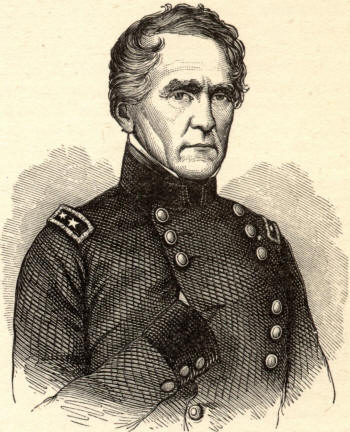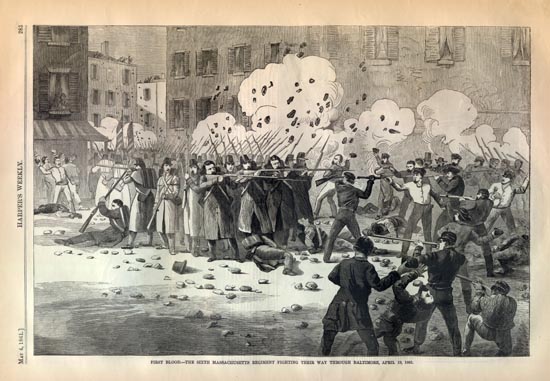General John Wool
![]()
This Site:
|
WOOL, JOHN ELLIS, military officer; born in Newburg, N. Y., Feb. 20, 17 84. His early education was meager, but before he was twenty-one he was owner of a bookstore in Troy. Losing his property by fire, he studied law, and on April 15, 1812, entered the army as captain in the 13th United States Infantry, raising a company in Troy. At the battle of Queenston Heights he was severely wounded: and, for gallantry in the battles at and near Plattsburg (Sept. 11, 1813), he was brevetted lieutenant-colonel. In 1841 he became brigadier-general. He had been sent to Europe by the government in 1832 to examine some of the military systems on that continent, and witnessed the siege of Antwerp. |
General John Wool |
|
In 1846 he organized and disciplined volunteers for the war with Mexico, and in less than six weeks dispatched to the seat of war 12,000 men fully armed and equipped. Collecting 3,000 men, he penetrated Mexico to Saltillo, after a march of 900 miles without loss. He selected the ground for the battle of Buena Vista, and commanded in the early part of the action until the arrival of General Taylor. For his conduct there he was brevetted major-general and received the thanks of Congress and a sword. The New York legislature also presented him with a sword. In 1856 he quelled Indian disturbances in Oregon, and was called to the command of the Department of the East, where he furnished the means for the salvation of the national capital and Fort Monroe from seizure in April, 1861. Attack on Massachusetts Troops in BaltimoreWhen he heard of the attack on Massachusetts troops in Baltimore, he hastened to Albany to confer with Governor Morgan. That official resolved to push forward troops to Washington as rapidly as possible. Wool issued orders to the United States quartermaster at New York to furnish all needful transportation, and the commissary of subsistence was directed to issue thirty days' rations to every soldier who might be ordered to Washington. Wool went to New York on the 22d, and made his headquarters at the St. Nicholas Hotel, where he was waited upon by the Union defense committee. A plan of operations for the salvation of the national capital was arranged between them. At that time all communication with the government was cut off by the Confederates in Baltimore. The general-in-chief (Scott) could not communicate with a regiment outside of the national capital, and Wool was compelled to act in conformity to the demands of the crisis, and to assume great responsibilities. Knowing General Scott's disposition, Wool said, " I shall probably be the only victim; but, under the circumstances, I am ready to make the sacrifice, if, thereby, the capital may be saved." With the tireless energy of a man of forty years he labored. Ships were chartered, supplies were furnished, and troops were forwarded to Washington with extraordinary dispatch, by way of Chesapeake Bay and the Potomac River. The transports were convoyed by armed steamers, to protect them from pirates, and one of them, the Quaker City, was sent to Hampton Roads. To the immensely important work, Fort Monroe, Wool sent gun-carriages, ammunition, and provisions, that it might be held to command the chief waters of Virginia. A dozen State governors applied to him, as the only superior military officer that could be reached, for advice and for munitions of war; and he assisted in arming no less than nine States. With rare vigilance he directed Governor Yates, of Illinois, to send a force to take possession of the arsenal at St. Louis, which he believed to be in danger. The movement was timely, and 21,000 stands of small-arms, two field-pieces, and 110,000 rounds of ammunition were transferred from St. Louis to Illinois. Troops and ammunition were ordered to Cairo, Ill., and New England governors were authorized to put the coast defenses within their respective States in good order. When the troops sent to Washington by Wool had opened communication with that city, the first dispatch that he received from Scott was an order (April 30) to return to his headquarters at Troy for the " recovery of his health, known to be feeble." The general's health was then perfect. A month afterwards General Wool was informed by the Secretary of War that he was sent into retirement because he had issued orders, " on the application of various governors, for arms, ammunition, etc., without consultation" with the authorities at Washington. He was made commander of Fort Monroe in August, 1861, and led the expedition that took possession of Norfolk, in May, 1862, in which month he was promoted major-general, United States army, and placed at the head of the 8th Army Corps, but did not appear in the field. He died in Troy, N. Y., Nov. 10, 1869. |
|
![]()
|
Site Copyright © 2003-2018 Son of the South. For questions or comments, contact paul@sonofthesouth.net. |
|
|
|
Are you Scared and Confused? Click Here to read My Snake Story, a story of hope and encouragement, to help you face your fears. |
||

